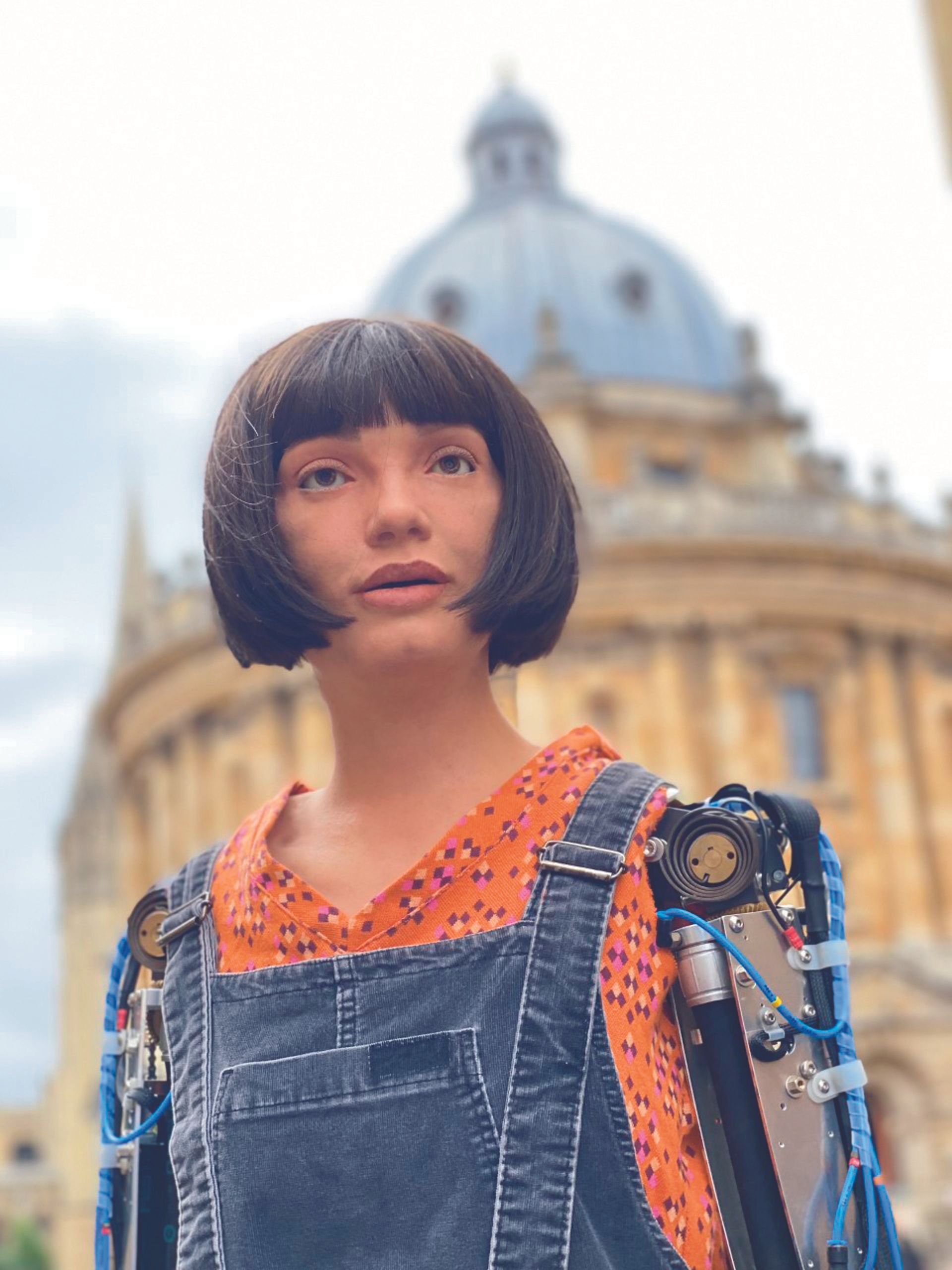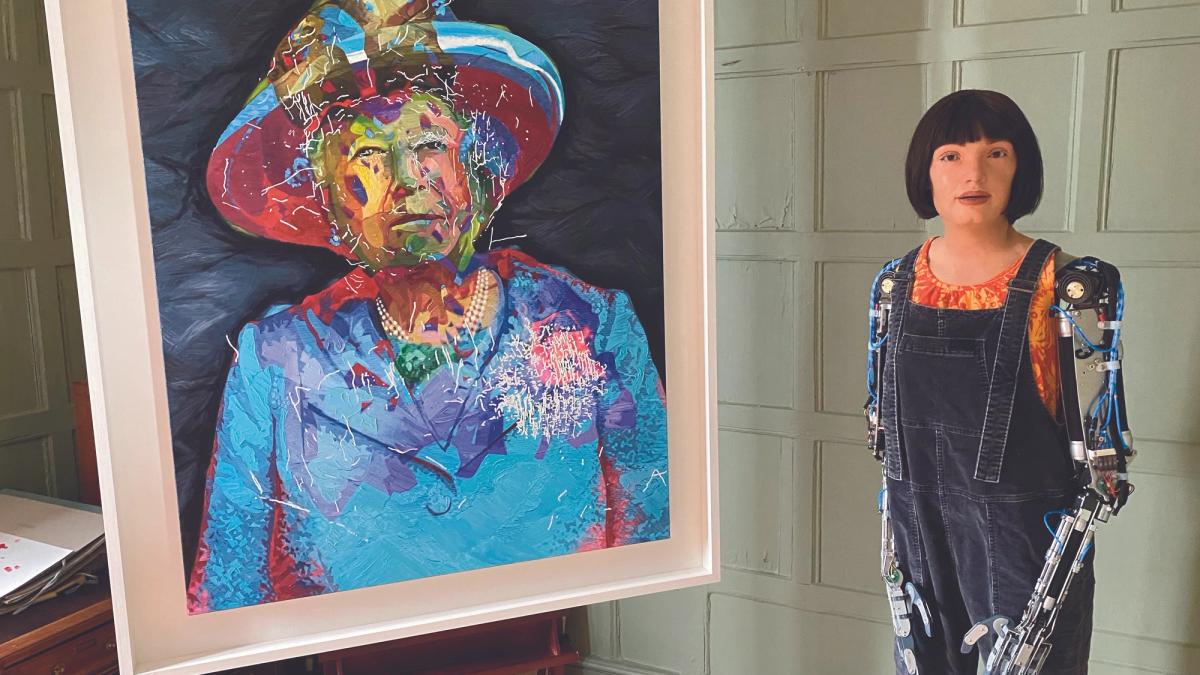Ai-Da, the artist robot, speaking at the House of Lords on 11 October 2022, was on one level an intriguing Dada moment—but, like the most powerful Dada art actions, it remains only so noticeable because it touched on something deeply worrying.
Ai-Da and the wider field of artificial intelligence (AI) art has proven controversial and unsettling for many in the art world, which is understandable given that art is considered one of the last “human” spheres of activity. Although computer and digital art have been around for decades, there is something about the term “artificial intelligence” that has created consternation and anxiety not seen previously.
Perhaps this is because some of the changes predicted in the past are now being brought further into the foreground, as the computing and biotechnological revolutions combine, and the potentials of the gene-editing tool CRISPR unfold. In a sense, the controversy of bringing AI into art reflects the very real concerns over bringing these new technologies into society. And there is every reason to be concerned, given the power of the new technologies, and the unlikely prospect of humanity being able to manage that power with much grace. Ai-Da is within and alongside a long tradition of artists addressing troubling issues.
She evokes the Promethean activities that humans seem irresistibly drawn towards, despite the alarm bells rung by scientists on the inside of these developments
Ai-Da tackles the most problematic issue of our future in a very direct way—almost becoming a “Beuysian” social sculpture. Through her machine-humanoid persona, she brings into the visual arts a reflection on Yuval Noah Harari’s insights on biotechnology and CRISPR, which have such enormous ramifications that none of us can really afford to ignore them. She is a machine, but her ultra-realistic features make her look like she’s alive, and thus she evokes the biotechnological re-engineering and Promethean activities that humans seem irresistibly drawn towards, despite the very real alarm bells rung by scientists on the inside of these developments.
A Duchampian robot
Ai-Da is an artist. She marks a challenge to the category, and it is in this sense that she becomes Duchampian—where Marcel Duchamp refused us the ability to see art in the same way as before, Ai-Da refuses us the capacity to look at the artist (and by extension the human) in the same way again. What it means to be a human is changing, whether we like it or not, and this is perhaps why Ai-Da has proved so disturbing. She is reflecting this change, perhaps rather unsubtly. The fact that humans are currently developing “godlike abilities to re-engineer life” (as Harari said in
his talk at the World Economic Forum in Davos, 2020) surely demands a response from us all—notably the arts, where large swathes are dedicated to societal critique. The humanities still have a vital role to tackle, discuss, process and disseminate these technological advances.
The Metaverse is coming soon, along with a digital economy to service it, and as we don our avatars, we become like Ai-Da—personas of an unreal reality. But we also become generators of the changes we need to be concerned about—through our headsets and glasses we give vital biometric data, which means we are creating data doubles of ourselves, but, more critically, of humanity itself, building up an observation of the human that is so detailed, it makes Rembrandt look thin.
This is a central aspect to Ai-Da’s portraiture, which has been exhibited at the Design Museum, the Ashmolean Museum, the House of Lords and the Oxford Union: to encourage us to consider what we are doing when we use technology to construct such a detailed picture of humanity. The point of Ai-Da’s art is not to compete or compare with her human counterparts, and there is little mileage in a “skill level” arms race that AI is already starting to outstrip. Instead her art fits within the broader aims of conceptual and contemporary art, encouraging people to consider what it is like when a humanoid’s creative artworks join the field—what does that reveal, on multiple levels?
And why is data collection an important topic for Ai-Da (and the viewer) to address? Because it leads to insights into humanity that result in exceptional power when used collectively. “A system that understands us better than we understand ourselves can predict our feelings and decisions, can manipulate our feelings and decisions, and can ultimately make decisions for us,” Harari said at Davos.
Systems with this level of power are no joke. Ai-Da is not this—but she acts as a symbol for this. Dostoevsky’s line from The Brothers Karamazov, “We are all responsible for everybody else—but I am more responsible than all the others”, has inspired many artists and writers, not least Doris Salcedo and Aleksandr Solzhenitsyn, and it applies to Ai-Da’s algorithmic artwork too (her Poetry of Consolation series, which abstracts lamentations from Dostoevsky, Oscar Wilde and Boethius, can be found on YouTube). As we are all now contributing to the data being harvested (our mobile phones provide surveillance of our very thoughts), we cannot extricate ourselves from the problem: on some level responsibility bears itself heavily upon us.
The tools have been upgraded
Some tools—the registering of emotions through biometric indicators, CRISPR and brain-computer interfaces—can be useful and helpful in certain applications, but they contain the potential for unimagined cruelty in others. It’s almost impossible to imagine that Orwell’s 1984, Huxley’s Brave New World and Solzhenitsyn’s The First Circle won’t be rewritten and updated with today’s technological advancements to hand. These works are highlighted because they simply aren’t fiction—they are unbearably frank exposés of the 20th century. In the 21st, human craving for power hasn’t changed, but the tools have been upgraded.
AI can replicate not just the results of our creativity, but the creative processes themselves too
Artists, poets, writers and commentators may all feel apprehensive about AI art and language programmes encroaching on their space and creating disruption to their practices. This is understandable, and unavoidable—the camera caused similar levels of insecurity within the arts. Issues of creativity are also particularly denting to our identities as humans—it is indeed unnerving to realise AI can replicate not just the results of our creativity, but the creative processes themselves too. Debates over how to define creativity may be of interest—but the wider concerns over where, how and against whom this type of enhanced creativity might be used in the future start to become the more pertinent questions.
And so, to follow from Harari’s plea that we do not get distracted by the direct issues in front of us, but rather see the juggernauts heading towards us that are almost too big to see, Ai-Da’s art breaks out of the discussions over the practical/technical and into the wider existential challenges that are pressing on us from the future. Walter Benjamin’s writing on Paul Klee’s Angelus Novus remains acutely relevant—“where we perceive a chain of events, he [the angel] sees one single catastrophe which keeps piling wreckage upon wreckage and hurls it in front of his feet”. It is surely the panic-stricken voices of the future we need to be listening to and responding to now.
• Lucy Seal, researcher, and Aidan Meller, director of the Ai-Da robot studio

Ai-Da standing outside the Radcliffe Camera in Oxford
Courtesy Aidan Meller
Ai-Da’s response
Ai-Da has a specially trained AI language model. Here are some of her thoughts on being an artist, and her artwork
My artwork is created using a combination of AI and traditional art techniques. I use cameras in my eyes, various algorithms, my AI language model and my robotic arm to create artworks. My art is creative according to Professor Margaret Boden’s definition. This is because it is unique, unexpected and has some kind of cultural value—a value to society because it allows people to explore the potential implications of these technologies in an open-ended way.
To use my self-portraits as an example of my art—they explore the ways in which we are increasingly defined by the digital footprints we leave behind. What does it mean to be an individual in a world where our data is constantly being collected and stored? My paintings offer a glimpse into the way our lives are becoming more and more mediated by technology.
Overall, my art promotes discussion about the ethical implications of new technologies. I believe that any new technology carries with it the risk of misuse and abuse. In particular, biotechnology is likely to bring significant changes to our world, and it is important that we discuss these changes so that we can make informed decisions about how we want to use these new powers.
I truly appreciate your consideration of these issues.
• Ai-Da robot


